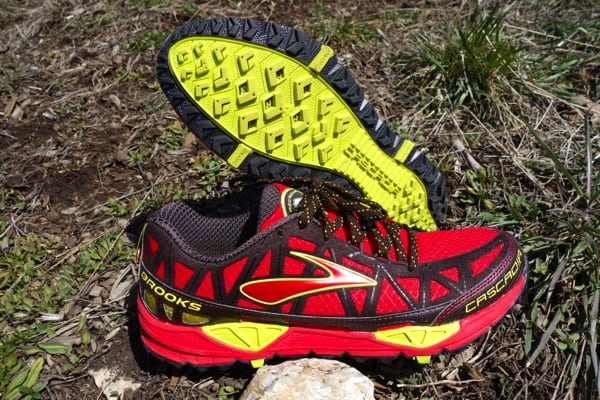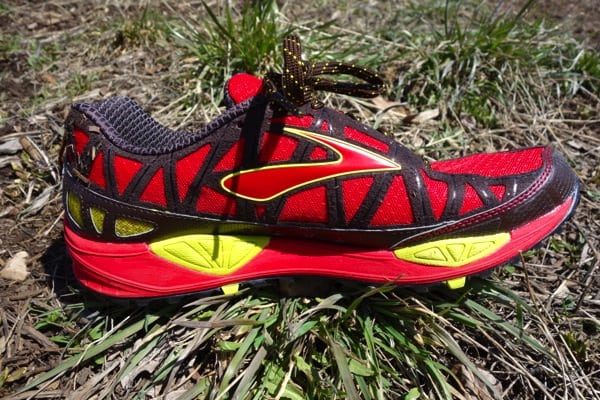Check out the most recent Cascadia in our Brooks Cascadia 18 review.
More Trail Running Shoe Options
To find more options for trail running shoes, check out our Best Trail Running Shoes article.
Brooks Cascadia 8 Review
I know that as I set out to review the new Brooks Cascadia 8 ($120), I hold the hopes and dreams of millions, okay thousands, of non-minimalist trail runners. One harsh sentence or critique could send them frantically to obscure websites looking for old Cascadias on closeout in an effort to get through another summer trail running season in their favorite shoes. Of course I’m joking, but the Cascadia is a shoe that I consistently see on the trails everyday, and one that I count as a benchmark for other highly protective trail shoes. Like a standard in the music world, a song that every musician worth their salt knows how to play, the Cascadia is a shoe which most runners have had some experience with.

The Brooks Cascadia 8
Upper
For those of you Cascadia loyalists out there, the majority of the changes take place in the upper and in my opinion these subtle changes are positive. A breathable but durable microfiber is crisscrossed by welded-on overlays throughout the majority of the shoe. The interior of the shoe is void of seams or any abrasive points apart from where the tongue attaches, which didn’t give me any problems. A synthetic rand runs the length of the shoe and connects to a fairly beefed-up toe bumper that is plenty protective.

The Cascadia 8’s lateral upper.
An asymmetrical lacing system uses a combination of floating eyelets and traditional, punched eyelets and provides a tightening sensation throughout the mid-foot and a very secure feel. This asymmetrical lacing is similar to that of the Cascadia 7, but improved in my opinion due to eyelet construction. A well-padded tongue stays in place and is complimented by a firm, reinforced heel cup.
Everything about this upper is what I would expect from the Cascadia, and I have no doubts that you could get 1000 miles out of it. Gone is the somewhat sloppy fit of the Cascadia 7 and the 8 feels like a secure shoe ready to tackle any terrain. Although I would like to see a slightly wider forefoot to accommodate foot swelling, I didn’t experience any irritation in the toe box.
Midsole
Very little, if anything, has changed between the Cascadia 7 and 8. [Editor’s Note for Shoe Geeks: There were some minor changes.] BioMogo and Brooks DNA cushioning are used in conjunction with a heel and forefoot pivoting system (think dual-density foam posts) to provide stability for pronators. That being said, these stability features don’t seem to get in the way for me as a neutral foot striker and I think they help the shoe hold up well during a long run. The feel of the Cascadia is firm and locked down, and I felt like I could take this shoe over a talus field and feel stable. The downside to this feeling is during faster outings the Cascadia 8 felt heavy and the heel differential high (10 mm) for technical trail running. Granted, I’m usually running in sub-10-ounce trail shoes (while these are 11.9 ounces), but I’d like to see a bit more of an agile feel.

The Cascadia 8’s medial upper.
Outsole
The Cascadia 8 employs a fairly general but effective outsole lug pattern. I liked that lug height was not a factor when running on roads or flat trails and the Cascadia felt great on the roads as usual. A fairly substantial rock plate kept me feeling very bulletproof over any terrain and I would consider this one of the most protective shoes I’ve ever worn. Brooks puts in the extra effort to use recycled materials to make the tacky outsole rubber, which is very cool, and after about ten longer runs in this shoe the outsole is showing no wear whatsoever.

The Cascadia 8’s outsole.
Overall Impressions
Without a doubt the eighth Cascadia will be a crowd pleaser. I enjoyed running in the Cascadia 7 and I think that they dialed in the fit a bit more with this version. I really can’t think of anything about this shoe I would change outside of making the forefoot just a tad wider, but it never bothered me during runs. If you regularly run in Cascadias you’re in the clear, as Brooks didn’t depart from the tried-and-true formula here.
However, I have to wonder if the Cascadia will retain its heralded place as a favorite of the masses. Trail shoe companies are seemingly back to focusing on protective shoes and many of them weigh one or two ounces less than the Cascadia (namely the New Balance MT1210 Leadville). While I can’t help wonder what a bit more agile Cascadia would feel like on the trail, having a reduced upper might defeat the purpose and heritage of the Cascadia completely, which in my opinion is its durability. In any group long run I can always depend on many of the elder statesman, those experienced salty dog veterans of our sport, sporting well-worn versions of past Cascadias without giving lighter-weight shoes even a second thought. Maybe just like Brooks, those old guys got it right a long time ago.
